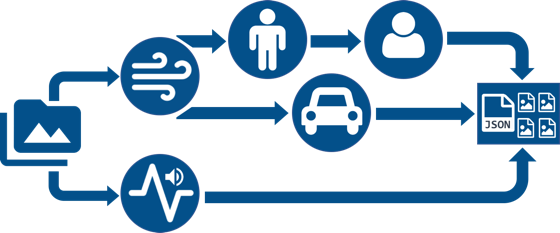The Open Media Processing Framework provides a platform to perform content detection and extraction on bulk multimedia, enabling users to analyze, search, and share information through the extraction of objects, keywords, thumbnails, and other contextual data.
OpenMPF enables users to build configurable media processing pipelines, enabling the rapid development and deployment of analytic algorithms and large-scale media processing applications.
Simplify large-scale media processing and enable the extraction of meaningful content
Apply cutting-edge algorithms such as face detection and object classification
Integrate into your
existing environment or use OpenMPF as a standalone application
Features
Web Interface & REST API
A modern Web UI enables users to easily process bulk media and:- Build configurable pipelines
- Create and monitor jobs
- Upload files for processing
- Monitor system logs and node status
- Administer configuration properties
- View processing statistics

Additionally, the REST API exposes the same core functionality as the Web UI and enables applications to be built on top of OpenMPF.
Open Plugin API
The OpenMPF Plugin Architecture provides the ability to seamlessly integrate detection, tracking, and classification algorithms in C++, Java, and Python.New processing nodes can easily be added to increase processing throughput and new algorithms can be dynamically loaded and scaled to meet user needs.

- Faces
- LBP-Based OpenCV
- Motion
- MOG with STRUCK
- SuBSENSE with STRUCK
- License Plates
- OpenALPR
- Speech
- Sphinx
- Azure Cognitive Services Batch Transcription API
- Scenes
- OpenCV
- Objects (Classification)
- OpenCV DNN (YOLO, GoogLeNet, Yahoo NSFW, vehicle color)
- Objects/Features (Classification)
- TensorRT (COCO classes)
- Text Regions
- EAST
- Text (OCR)
- Tesseract
- Apache Tika
- Azure Cognitive Services Computer Vision API (OCR endpoint)
- Azure Cognitive Services Read API
- Form Structure (with OCR)
- Azure Cognitive Services Form Recognizer API
- Keywords
- Boost Regular Expressions
- Document Images
- Apache Tika
- Translation (Language)
- Azure Cognitive Services Translate API
Customizable Pipelines
OpenMPF provides the ability to to combine multiple algorithms in a single pipeline. Algorithms can be organized sequentially or in parallel.
Getting Started
To start using OpenMPF, follow the OpenMPF Install Guide.
Contact Us!
For questions, contact the OpenMPF Dev Team and we'd be happy to help!